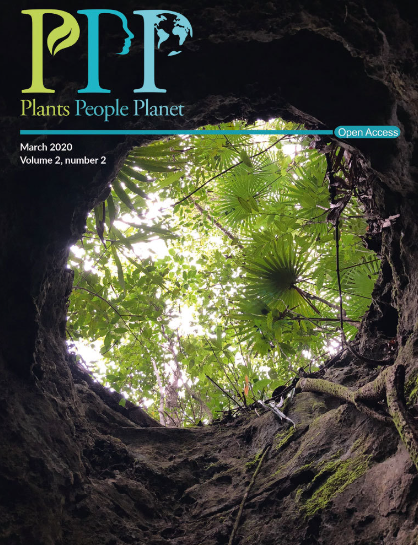Farming cattle in the tropics: Transnational science and industrializing pastures in Brazil
IF 3.6
2区 环境科学与生态学
Q1 BIODIVERSITY CONSERVATION
引用次数: 0
Abstract
Societal Impact Statement Society is increasingly concerned over the environmental impact of diets. Much of this concern is over the environmentally destructive nature of meat production, especially beef and especially in the Amazon. This article aims to understand the production of beef in Brazil through the understudied perspective of forage grasses. In doing so, the article traces who was involved in the importation and improvement of forage grasses in Brazil, why they were involved, and what the consequences of their actions were. By centering forage grasses, we can better understand the potential consequences of seemingly unimportant plant breeding efforts. Summary Beef is viewed by many as one of the more environmentally destructive foods today. Whether it is deforestation in the Amazon or concentrated feedlots, the rancher and the cow have come to epitomize the dangers of a global industrial food system. This article looks at the industrialization of beef cattle from another angle, a bit closer to the ground. It looks at the role and circulation of plants and plant breeders in the expansion of beef cattle in the Brazilian tropics. The article draws on documents collected from the institutional archives of the Brazilian Agricultural Research Corporation, known by its Portuguese acronym Embrapa and the Rockefeller Archive Center. Additional archival documents were acquired by a personal contact. Embrapa was established in 1973, but its archives contain documents from Brazilian agricultural research agencies from as far back as 1952. Documents from the Rockefeller Archive Center include research bulletins and reports from Nelson Rockefeller's IBEC Research Institute (IRI), which conducted research on forage grasses from the 1950s until the 1970s. The article puts forth the argument that imported and improved forage grasses made large‐scale cattle ranching environmentally viable and economically profitable in Brazil. One type of grass in particular, Brachiaria , was central in propelling Brazil as the world's largest producer of beef and underpinning perhaps the most environmentally and socially destructive cattle ranching system in the world. Brachiaria was a key biological and technological input to further entrench longstanding structural inequalities of land ownership. One of the key conclusions of this article is that perspectives from the margins can be illustrative of how seemingly unimportant research (forage grass breeding) can have massive consequences as part of a broader socio‐environmental system.热带地区的养牛:巴西的跨国科学和工业化牧场
社会越来越关注饮食对环境的影响。这种担忧主要是关于肉类生产对环境的破坏,尤其是牛肉,尤其是在亚马逊地区。这篇文章的目的是了解牛肉生产在巴西通过饲料草研究不足的角度。在此过程中,文章追溯了谁参与了巴西牧草的进口和改进,他们为什么参与,以及他们的行为的后果是什么。通过以饲草为中心,我们可以更好地理解看似不重要的植物育种努力的潜在后果。牛肉被许多人视为当今最具环境破坏性的食物之一。无论是亚马逊的森林砍伐,还是集中的饲养场,牧场主和奶牛已经成为全球工业化食品体系危险的缩影。本文从另一个更贴近实际的角度来审视肉牛的产业化。它着眼于植物和植物育种者在巴西热带地区肉牛扩张中的作用和循环。这篇文章借鉴了从巴西农业研究公司和洛克菲勒档案中心的机构档案中收集的文件。巴西农业研究公司的葡萄牙语缩写为Embrapa。另外的档案文件是通过个人接触获得的。Embrapa成立于1973年,但其档案中包含的巴西农业研究机构的文件可以追溯到1952年。洛克菲勒档案中心的文件包括纳尔逊·洛克菲勒的IBEC研究所(IRI)的研究公报和报告,该研究所从20世纪50年代到70年代对牧草进行了研究。本文提出的论点是,进口和改良的牧草使巴西大规模养牛在环境上可行,在经济上有利可图。尤其是一种名为Brachiaria的草,它在推动巴西成为世界上最大的牛肉生产国方面发挥了核心作用,并支撑着可能是世界上最具环境和社会破坏性的养牛系统。腕足菌是进一步巩固长期存在的土地所有权结构性不平等的关键生物和技术投入。本文的一个关键结论是,从边缘的角度可以说明看似不重要的研究(牧草育种)如何作为更广泛的社会环境系统的一部分产生巨大的后果。
本文章由计算机程序翻译,如有差异,请以英文原文为准。
求助全文
约1分钟内获得全文
求助全文
来源期刊

Plants People Planet
Multiple-
CiteScore
9.90
自引率
5.90%
发文量
81
审稿时长
12 weeks
期刊介绍:
Plants, People, Planet aims to publish outstanding research across the plant sciences, placing it firmly within the context of its wider relevance to people, society and the planet. We encourage scientists to consider carefully the potential impact of their research on people’s daily lives, on society, and on the world in which we live. We welcome submissions from all areas of plant sciences, from ecosystem studies to molecular genetics, and particularly encourage interdisciplinary studies, for instance within the social and medical sciences and chemistry and engineering.
 求助内容:
求助内容: 应助结果提醒方式:
应助结果提醒方式:


